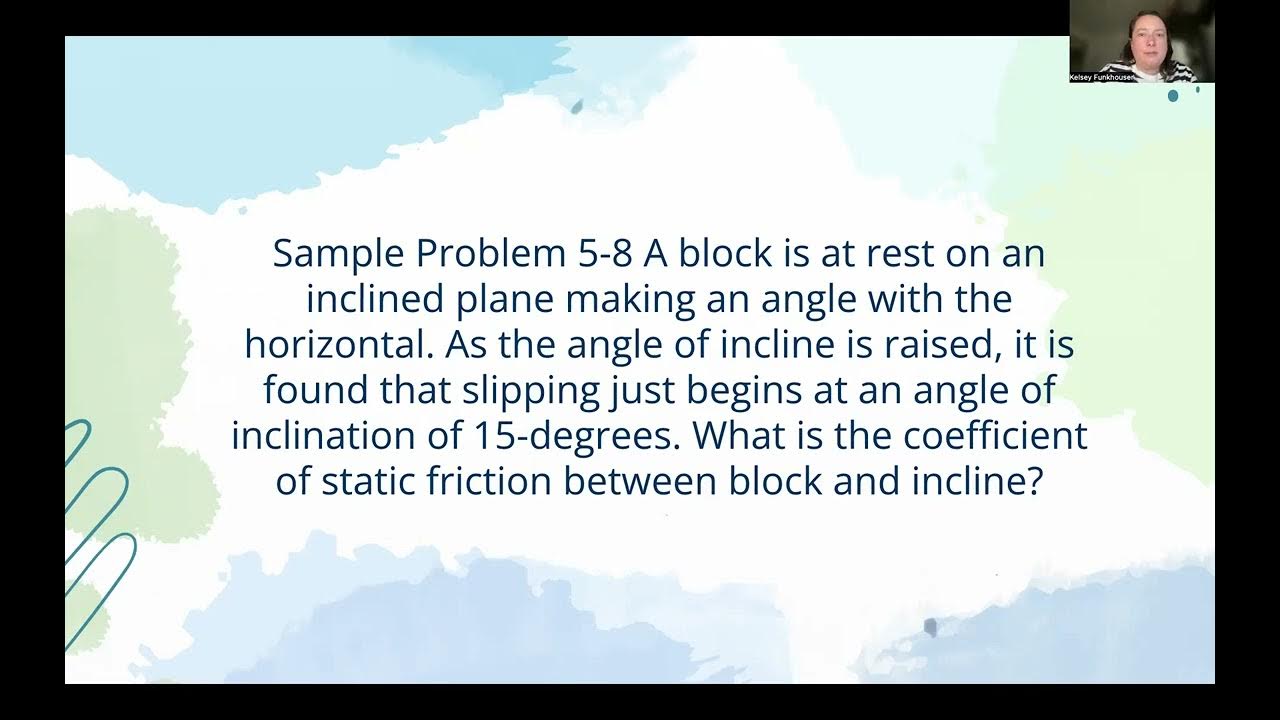Friction: Crash Course Physics #6
Summary
TLDRIn this Crash Course Physics episode, the concept of friction is explored, focusing on its two types: kinetic and static friction. The video explains how friction affects movement, from slowing down sliding objects to resisting initial motion. Through a relatable example of moving furniture and calculating friction on a ramp, the video dives into the science of frictional forces, including the role of normal force and the coefficients of friction. Viewers also learn how to apply these principles to real-world scenarios and use them to solve problems related to motion and friction.
Takeaways
- 😀 Friction is a force that resists motion between two surfaces in contact.
- 😀 There are two types of friction: kinetic friction (resists motion once the object is moving) and static friction (prevents motion from starting).
- 😀 Friction plays a key role in everyday activities, such as sliding into home plate in baseball or picking up a cup.
- 😀 Kinetic friction generates heat and sound as surfaces interact and break weak bonds while moving.
- 😀 The strength of kinetic friction depends on the roughness of the materials and the normal force (the force pressing the materials together).
- 😀 The coefficient of kinetic friction (μ_k) measures the roughness between two surfaces and influences how easily they slide past each other.
- 😀 Static friction adjusts in strength to match the force applied, up to a maximum limit, before an object begins to move.
- 😀 The maximum static friction is determined by the coefficient of static friction (μ_s) and the normal force.
- 😀 The normal force is the force exerted by a surface that supports the weight of an object resting on it, and it’s equal and opposite to the object's weight in most situations.
- 😀 To solve problems involving friction, use free-body diagrams, separate vectors into components, and apply Newton’s second law (F_net = ma) to find the net forces and the object’s motion.
- 😀 When dealing with a box on a ramp, use trigonometry to separate gravitational forces into components along and perpendicular to the ramp's surface to calculate normal force and friction.
Q & A
What is the primary role of friction in real-life situations?
-Friction is essential for many everyday activities. It allows us to pick up objects without them slipping through our fingers and helps stop movements, such as a baseball player sliding into home plate.
What are the two types of friction discussed in the video?
-The two types of friction are kinetic friction, which resists sliding motion once an object is already moving, and static friction, which resists the initiation of motion.
How does kinetic friction work when moving a bookcase?
-Kinetic friction acts opposite to the direction of motion, resisting the sliding of the bookcase. It also generates heat and sound as the surfaces of the objects interact and break weak bonds.
What causes kinetic friction between two surfaces?
-Kinetic friction is caused by the microscopic bumps and grooves on the surfaces of materials. As objects move against each other, these surfaces catch and form weak bonds, resisting motion.
What is the coefficient of kinetic friction, and how does it affect frictional force?
-The coefficient of kinetic friction (μ_k) measures the roughness between two materials. It directly influences the strength of kinetic friction, with higher values indicating stronger resistance.
How does the normal force affect friction?
-The normal force (F_N) is the force exerted by a surface to support the weight of an object. It increases friction because more force pushing the materials together means more surface contact and higher resistance.
What is the equation for kinetic friction?
-The equation for kinetic friction is: F_k = μ_k * F_N, where F_k is the force of kinetic friction, μ_k is the coefficient of kinetic friction, and F_N is the normal force.
What happens when static friction is overcome?
-When static friction is overcome, the object starts to move. Static friction can vary in strength, adjusting to the amount of force applied until it reaches its maximum value.
How does the maximum static friction relate to the normal force?
-The maximum static friction is calculated using the equation: F_s(max) = μ_s * F_N, where μ_s is the coefficient of static friction, and F_N is the normal force. The stronger the normal force, the greater the maximum static friction.
How do you analyze friction in a scenario involving an object on a ramp?
-To analyze friction on a ramp, you first draw a free-body diagram, choose axes, and resolve the gravitational force into components. The frictional forces, such as static and kinetic friction, will act against the movement, and the normal force will adjust based on the ramp's angle.
Outlines

このセクションは有料ユーザー限定です。 アクセスするには、アップグレードをお願いします。
今すぐアップグレードMindmap

このセクションは有料ユーザー限定です。 アクセスするには、アップグレードをお願いします。
今すぐアップグレードKeywords

このセクションは有料ユーザー限定です。 アクセスするには、アップグレードをお願いします。
今すぐアップグレードHighlights

このセクションは有料ユーザー限定です。 アクセスするには、アップグレードをお願いします。
今すぐアップグレードTranscripts

このセクションは有料ユーザー限定です。 アクセスするには、アップグレードをお願いします。
今すぐアップグレード関連動画をさらに表示

Fuerza de fricción o rozamiento

Law Of Motion || Types Of Friction || Lecture No. 18

PHYS 121 - Week 4 Lecture 2 - Friction & Circular Motion

Contoh Soal FISIKA SMA - Gaya Gesek Kinetis dan Statis

FISICA! forza d’attrito, fisica attrito, attrito statico e dinamico, forza d’attrito esercizi

Friction 5 (Static and Kinetic)
5.0 / 5 (0 votes)
